Source audio Nemesis Delay User Manual
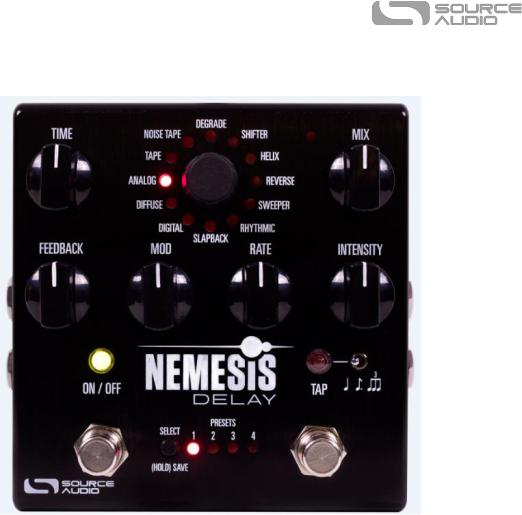
Nemesis Delay User’s Guide
Welcome
Thank you for purchasing the Nemesis Delay. This powerful stereo delay pedal features a collection of meticulously crafted sounds ranging from analog, tape, and slapback to multi-tap, filtered, pitchshifted, bit-crushed experimental effects charting new sonic territory. With an intuitive and simple control set, the Nemesis can work in a wide variety of musical settings, and the powerful MIDI and Neuro App control options (iOS/Android) provide access to a vast array of additional tonal possibilities.
The Nemesis is housed in a durable, extruded aluminum housing, packing rack mount power and flexibility into a compact, easy-to-use stompbox.
The Quick Start guide will help you with the basics. For more in-depth information about the Nemesis Delay, move on to the following sections starting with Connections. Enjoy!
-The Source Audio Team
SA260 |
Nemesis Delay User’s Guide |
1 |

Overview
24 Diverse Delay Engines – Choose from vintage delay tones such as Analog Bucket Brigade, Tape, and Slapback, or delve deeper into unique sounds cooked up in the Source Audio lab. 12 factory delay engines are available out of the box, 12 extended engines can be recalled via MIDI or loaded via the Neuro App.
Flexible Stereo Routing – The Nemesis is equally at home in a mono rig or a stereo rig. Every delay effect engine works in stereo multi-tap mode, and a variety of routing modes such as Mono-to-Mono, Mono-to-Stereo, and External Loop allow the Nemesis to harness the true power of stereo signal chains.
Single Delays, Dual Delays, Multi-Tap Delays – Every Nemesis delay engine comes ready to go with both single and dual delay modes. Some delay engines make use of the Nemesis’ 5-tap architecture to create unique multi-tap delays and rhythmic patterns.
Compact Design – The durable, anodized aluminum housing with its slim profile and small footprint is built for the rigors of the road.
Universal Bypass – True bypass, buffered bypass, or soft bypass with delay trails? The choice is yours. The Nemesis features high-quality signal relays for true bypass and transparent buffers for analog bypass, and soft bypass mode for preserving delay trails or complex stereo signal routing during bypass.
Presets – Save your favorite sounds with the touch of a button. 8 presets can be stored and recalled using the hardware controls, and a total of 128 presets can be saved internally and recalled using a MIDI controller.
Deep Control Set – Beyond the six control knobs on the face of the Nemesis are many additional editable parameters. The Neuro App provides access to the inner workings of the delay effect for advanced users who want to create a unique signature sounds.
Neuro App – The Neuro App for iOS and Android offers a powerful extension to the basic pedal functionality. Access the full set of editable parameters and save presets on your mobile device. Edit and share your favorite sounds with the Neuro Community directly from the App!
Neuro Hub – The Source Audio Neuro Hub connects up to five compatible Source Audio pedals and stores the settings of each pedal as a scene. Up to 128 scenes can be saved and recalled using the Neuro Hub, combining the power of a multi-effects system with the flexibility of a traditional pedal board.
External Loop – Configure external loop mode to insert external effects in the delay line of the Nemesis, making them part of the feedback loop.
Full MIDI Implementation – The Nemesis' parameters can be accessed and controlled using MIDI via the Neuro Hub or USB. Class compliant USB-MIDI allows the Nemesis to work as a plug-and-play device with recording software running on Mac and Windows. The Nemesis can also sync to your DAW or other MIDI devices using MIDI clock.
SA260 |
Nemesis Delay User’s Guide |
2 |
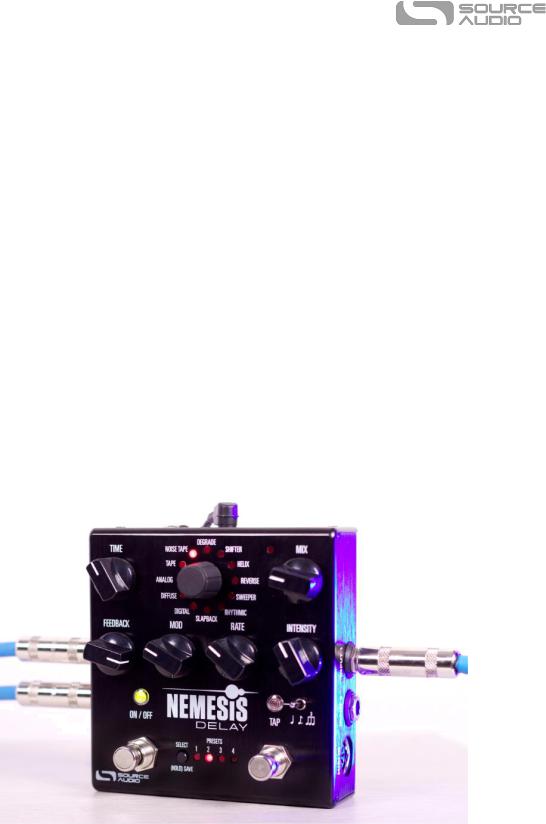
Tap Tempo – The TAP FOOTSWITCH allows users to directly set the delay time, with optional beat subdivisions.
External Control – The Nemesis can be easily configured to work with a variety of expression pedals and footswitches for various external control options.
Hold Mode – Sustain your delay sounds with the HOLD function. The delayed audio is repeated infinitely for ambient sustain effects.
Quick Start
Power
To power the unit, connect the included 9V DC power supply to the jack labeled DC 9V on the back panel.
Warning: Using a non-Source Audio supply, especially an unregulated supply, could damage the unit. Please be very cautious when using 3rd-party power supplies and refer to the power supply requirements printed on the bottom of the Nemesis housing.
Guitar/Audio Connections
Using standard ¼” mono cables, connect your guitar, bass, or other instrument to the INPUT 1 jack and your amp (or the next audio device in the signal chain) to the OUTPUT 1 jack. If you have a second amp, connect it to OUTPUT 2.
When the power and audio connections have been made, the Nemesis is ready to use.
SA260 |
Nemesis Delay User’s Guide |
3 |

Brief Knob, Footswitch, and Button Descriptions
Time Knob: Controls the delay time. If an effect engine uses multi-tap delays, this will set the time for the longest delay tap, and the sub-delays will automatically scale according to that.
Mix Knob: Controls the relative level between the dry input signal and the wet, processed signal. When set at 12 o'clock, the wet and dry signals will be at equal volume. Fully counter-clockwise is 100% dry, and fully clockwise is 100% wet.
Feedback Knob: Controls the amount of wet signal that is fed back into the delay effect. At minimum feedback, the delay effect will only process once. At maximum feedback, the delays will continue infinitely. It is also possible to set a feedback greater than 1, allowing for "self-oscillation" effects.
Mod Knob: Controls the depth of the modulation applied to the effect. It can have different functions depending on which engine is selected. Some effect engines use time (pitch) modulation, filter modulation, tape modulation (wow and flutter), or tremolo.
Rate Knob: This controls the speed of the time (pitch) modulation, filter modulation, wow and flutter, or tremolo. In tape delays, this simulates the tape speed.
Intensity Knob: The INTENSITY KNOB changes function depending on which engine is selected. Most effect engines can create a range of different sounds: warm to bright, clean to distorted, full to thin, and so on. The INTENSITY KNOB changes the color or character of the sound and allows you to dial in a unique flavor for each effect engine. The details of how the INTENSITY KNOB works are described in more detail in the individual descriptions of each effect engine.
Engine Selector Knob: Selects between the 12 main effect engines. To access the additional delay engines (the “back 12”), you’ll need to use the Neuro App or MIDI.
On/Off Footswitch: Engages or bypasses the delay effect. The corresponding ON/OFF LED will be lit when the delay effect is engaged.
Tap Tempo Footswitch: Tap this footswitch two or more times to set the primary delay time. Make sure the SUBDIVISION SWITCH is set to quarter notes for basic quarter note operation.
Press and hold the TAP footswitch to active HOLD mode. This will circulate the audio in the delay line infinitely until the TAP switch is released.
Tap Tempo Subdivision Switch: Selects a beat subdivision for tap tempo, allowing more complex delay times such as dotted eighths and triplets to be tapped in using the TAP FOOTSWITCH. The TAP LED will always blink in time with the duration you tapped in with the TAP FOOTSWITCH, even if a subdivision is selected.
Preset Select/Save Button: This button selects and loads one of the four user presets saved in the Nemesis. To save a preset into the currently selected spot, press and hold this button.
Automatic Stereo Detection: When a plug is inserted into the stereo output, the Nemesis will automatically detect it and generate a stereo ping pong delay effect for any of the delay machines. The Nemesis monitors its input and output connections and configures itself to the appropriate
SA260 |
Nemesis Delay User’s Guide |
4 |

mode. It’s also possible to override this and choose a custom routing mode using the Neuro App or
MIDI.
Contents |
|
Welcome.................................................................................................................................................. |
1 |
Overview.................................................................................................................................................. |
2 |
Quick Start ............................................................................................................................................... |
3 |
Connections ............................................................................................................................................. |
6 |
Delay Engines........................................................................................................................................... |
9 |
Extended Delay Engines......................................................................................................................... |
14 |
Controls.................................................................................................................................................. |
19 |
Preset Storage and Recall ...................................................................................................................... |
23 |
Universal Bypass .................................................................................................................................... |
25 |
Stereo Operation ................................................................................................................................... |
25 |
External Control..................................................................................................................................... |
28 |
Neuro App.............................................................................................................................................. |
33 |
Neuro Hub.............................................................................................................................................. |
41 |
MIDI ....................................................................................................................................................... |
41 |
USB......................................................................................................................................................... |
42 |
Specifications......................................................................................................................................... |
42 |
Troubleshooting..................................................................................................................................... |
43 |
Frequently Asked Questions.................................................................................................................. |
44 |
MIDI Implementation ............................................................................................................................ |
45 |
Rubber Feet ........................................................................................................................................... |
46 |
Waste Disposal Notes ............................................................................................................................ |
46 |
Warranty................................................................................................................................................ |
46 |
Version History ...................................................................................................................................... |
48 |
SA260 |
Nemesis Delay User’s Guide |
5 |
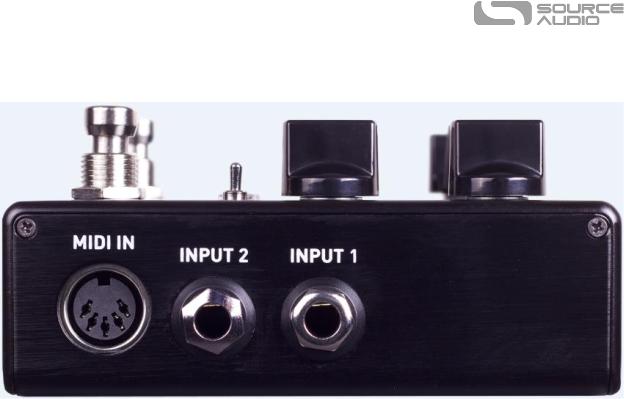
Connections
Input Side Connections
Input 1
INPUT 1 is the primary input for guitar, bass, or other instruments. It can also accept line-level inputs and will work in your amp’s effect loop. Connect it to your instrument or other audio source using a mono (TS) ¼” cable. Details about the allowed signal levels are available in the Specifications section.
Input 2
INPUT 2 is the secondary audio input for stereo sources, external feedback loop input, or as the data connection to your mobile device when using the Neuro App.
Input 2 as an Audio Input
The tip contact on INPUT 2 acts as a secondary input for guitar, bass, or other instruments. Connect your instrument (or the previous effect in the signal chain) using a mono (TS) ¼” cable. The Nemesis will automatically configure itself for stereo audio input. Other routing options are available using the Neuro App. For more information about stereo routing, refer to the Stereo Operation section.
Input 2 as an External Loop Return
If the Nemesis is configured in a routing mode that includes an external loop, OUTPUT 2 is the loop send and INPUT 2 is the loop return. Connect INPUT 2 to the output of the external effects loop using a mono (TS) ¼” cable.
Input 2 as a Neuro App Data Input
The ring contact on INPUT 2 acts as a data connection for the Neuro App. The Neuro App sends data to the pedal using your mobile device’s headphone jack. Connect it to your mobile device using the included stereo (TRS) 1/8” to ¼” cable. It can also accept daisy-chained Neuro data from another Neuro-compatible pedal in the chain, provided that a TRS cable is used. The audio signal (if applicable) will be on the tip contact of the plug, and the Neuro App data will be on the ring contact. This allows audio and Neuro data to flow on the same cable.
SA260 |
Nemesis Delay User’s Guide |
6 |
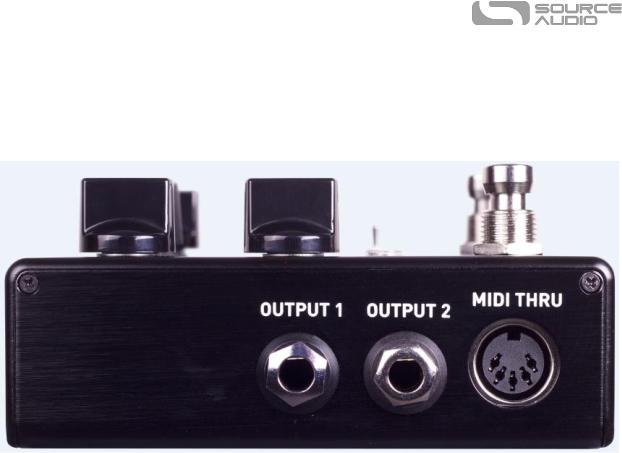
MIDI Input
This is a standard 5-pin DIN connector that accepts MIDI control messages from external devices, including program changes, continuous controllers (CCs), and MIDI clock. See the “Nemesis MIDI Implementation” document for details.
Output Side Connections
Output 1
This is the primary audio output. Connect it to your amplifier, recording interface, or the next device in your effects signal chain using a mono (TS) ¼” cable.
Output 2
OUTPUT 2 can act either as an audio output, external loop output, or as the daisy-chain data connection for the Neuro App.
Output 2 as an Audio Output
The tip contact on OUTPUT 2 acts as the secondary audio output. It carries an audio signal when the Nemesis is configured with a signal routing that uses stereo outputs. Connect it to your amplifier, recording interface, or the next device in your effects signal chain using a mono (TS) ¼” cable.
Output 2 as an External Loop Send
If the Nemesis is configured in a routing mode that includes an external loop, OUTPUT 2 is the loop send and INPUT 2 is the loop return. Connect OUTPUT 2 to the input of the external effects loop using a mono (TS) ¼” cable.
Output 2 as a Neuro App Data Daisy-Chain Output
The ring contact on OUTPUT 2 acts as a data connection for the Neuro App, passing data from the Nemesis to the next Source Audio effect in your signal chain. You can daisy-chain the Neuro App data regardless of whether OUTPUT 2 is configured to output audio or not. Connect OUTPUT 2 to the next device’s Neuro App Data input (usually INPUT 2) using a stereo (TRS) ¼” cable. The audio signal (if
SA260 |
Nemesis Delay User’s Guide |
7 |

applicable) will be on the tip contact of the plug, and the Neuro App data will be on the ring contact. This allows audio and Neuro data to flow on the same cable.
MIDI Thru
This is a standard 5-pin DIN connector that echoes MIDI messages from the MIDI INPUT jack and sends them to other devices. The Nemesis does not generate any of its own MIDI data, but it will copy and output any data it receives.
Power and Control Connections
DC 9V (Power)
Connect to the included 9 Volt DC power supply. If you would like to use a 3rd-party supply, the power supply must be regulated at 9 Volts DC (direct current), able to source at least 200 mA (milliamps) of current, and the plug should have a tip-negative, barrel-positive polarity.
USB
Connect to your computer (Mac or Windows) to the Nemesis’ USB port (denoted by the icon) using a standard mini USB cable. The Nemesis is a class compliant USB device, meaning that it does not require any custom drivers. For more information about the Nemesis’s USB capabilities, refer to the USB section of the User’s Guide.
icon) using a standard mini USB cable. The Nemesis is a class compliant USB device, meaning that it does not require any custom drivers. For more information about the Nemesis’s USB capabilities, refer to the USB section of the User’s Guide.
Control Input
The 3.5 mm CONTROL INPUT port connects to external control devices such as the Source Audio Dual Expression Pedal, Reflex Universal Expression Pedal, Neuro Hub, and Hot Hand Motion Controller. For more information, refer to the Expression Pedal Input, Hot Hand Input, and Neuro Hub sections of the User’s Guide.
SA260 |
Nemesis Delay User’s Guide |
8 |

Expression/Switch Pedal Input
The PEDAL IN jack on the back panel connects to either an external passive expression pedal or footswitch. The PEDAL IN SWITCH allows the user to select which type of external controller is being used. Set to EXP for expression control or SWITCH for footswitch control.
See the External Control section for details.
Delay Engines
The Nemesis includes twelve basic delay effect engines, with 12 extended engines available via the Neuro mobile app or MIDI. While some of the sound and functionality for each engine is fixed, many parameters and controls can be edited using the Neuro App or MIDI to tweak the sounds to fit specific use cases or to adjust to taste. Changes to the engines can be saved as user presets or
“burned” to override the factory settings of the effect dial.
Each effect engine uses the MOD KNOB, RATE KNOB, and INTENSITY KNOB in different ways to change the sound of the effect. Here is a description of each effect engine and how the knobs are configured respectively:
DIGITAL (0)
A classic clear digital delay with optional delay time (pitch) modulation. The INTENSITY KNOB controls filtering allowing for low cut (high pass) filters (creating a thinner delay sound) or high cut (low pass) filters (creating a warmer delay sound). Or, set the INTENSITY KNOB at 12 o’clock for a pure, unfiltered delay. The Nemesis features a 56-bit signal path with a 24-bit delay line for pristine digital delays.
Time Knob Range: 10 milliseconds to 2.6 seconds
Mod and Rate: Control time (pitch) modulation depth and speed.
Intensity: Controls filtering on the delayed signal. A high cut filter is available on the left side of the knob while a low cut filter is available on the right side. The middle range of the knob disables both filters.
Clean
Warm Bright
Dark Thin
DIFFUSE (1)
This engine features a diffusion effect that smears the attack of the repeated signal, softening it and allowing it to blend in more easily with the unprocessed dry signal. This creates an ethereal sound reminiscent of some reverb effects. There is also some subtle filtering to shape the sound of the repeats.
Time Knob Range: 30 milliseconds to 2.6 seconds
Mod and Rate: Control time (pitch) modulation depth and speed.
SA260 |
Nemesis Delay User’s Guide |
9 |

Intensity: Controls the strength of the diffusion effect.
Moderate Diffusion
Subtle Diffusion |
Intense Diffusion |
ANALOG (2)
This delay engine reproduces the characteristic dark sound of bucket brigade analog delays. Traditional analog bucket brigade delays can be either resonant or warm. This engine focuses on warmth, and was inspired in part by the classic EHX Deluxe Memory Man delay. True to the nature of older bucket brigade delays, treble frequencies are reduced, even on the clean (dry) signal. If you prefer a completely clean dry signal, this filtering can be disabled using the Neuro App or MIDI. For more resonance, try the RESONANT ANALOG engine.
Time Knob Range: 40 milliseconds to 1.2 seconds
Mod and Rate: Control time (pitch) modulation depth and speed.
Intensity: Morphs between a dark and bright sounding delay.
Dark Bright
TAPE (3)
A detailed re-creation of classic moving-head tape delays. Repeats are bandwidth limited and have artifacts characteristic of tape delay, such as filtering, preamp saturation, noise, wow and flutter.
Time Knob Range: 20 milliseconds to 1.2 seconds
Mod and Rate: MOD controls wow and flutter depth and RATE controls tape speed.
Intensity: Controls the amount of filtering, noise and distortion applied to repeats.
Saturated, Warm |
Bright, Clean |
|
|
|
|
|
SA260 |
Nemesis Delay User’s Guide |
10 |
||

NOISE TAPE (4)
A detailed re-creation of classic fixed-head variable-speed tape delays. Repeats are bandwidth limited and have artifacts characteristic of tape delay, such as filtering, distortion, noise, wow and flutter. NOISE TAPE is grittier and darker than the TAPE engine, and has artifacts that mimic old or damaged tape.
Time Knob Range: 20 milliseconds to 1.2 seconds
Mod and Rate: MOD controls wow and flutter depth and RATE controls tape speed.
Intensity: Controls the amount of filtering, noise and distortion applied to repeats.
Warm, Dirty
Dark, Distorted |
Bright, Saturated |
DEGRADE (5)
A delay with distortion and sample rate reduction. This creates unique lo-fi sounds with varying amounts of distortion, noise, and aliasing. For more extreme degradation and bit-crushing, try the LO-FI RETRO engine.
Time Knob Range: 10 milliseconds to 2.6 seconds
Mod and Rate: Control time (pitch) modulation depth and speed.
Intensity: Controls the amount of distortion and sample rate reduction applied to repeats.
Clean, |
Full |
Degraded, Thin, Aliased |
||
|
|
|
|
|
|
|
|
|
|
SHIFTER (6)
A delay with pitch-shifting on the delayed signal. The pitch shift is static; that is, pitch shifting does not compound with successive repeats.
Time Knob Range: 1 millisecond to 2.6 seconds
Mod and Rate: Control time (pitch) modulation depth and speed for a vibrato effect.
Intensity: Controls the pitch shift interval applied to repeats from an octave down to an octave up. Six pitch shifts are possible: down octave, up minor 3rd, up major 3rd, up perfect 4th, up perfect 5th, and up octave.
SA260 |
Nemesis Delay User’s Guide |
11 |

Up Major |
3rd |
|
Up |
Perfect 4th |
|
|
|
|
|
Up Minor 3rd |
|
Up |
Perfect 5th |
Down Octave |
|
|
|
Up |
Octave |
||
HELIX (7)
Combines reverse delay with an octave up pitch shift to create an ambient, shimmering delay that disappears into the upper frequency range.
Time Knob Range: 200 milliseconds to 2.6 seconds
Mod and Rate: Control time (pitch) modulation depth and speed.
Intensity: Sweeps from a warm and more subtle sound to a bright, shimmering, prominent effect.
Warm, Subtle |
Bright, Overt |
REVERSE (8)
A classic reverse tape sound that became popular in 60s psychedelic rock. The Nemesis can create several overlapping reversed delays that fade in and fade out regularly to create a pulsing tremolo effect. The INTENSITY KNOB mixes in additional delay taps to add more layering to the reverse sound.
Time Knob Range: 200 milliseconds to 2.6 seconds
Mod and Rate: Control time (pitch) modulation depth and speed.
Intensity: For a pure, single reverse, set the INTENSITY KNOB to minimum. Turn the INTENSITY KNOB up to mix in additional layers, creating a thicker, complex and more ambient reverse sound.
Single Reverse |
Multi |
-Tap Reverse |
||
|
|
|
|
|
|
|
|
|
|
SA260 |
Nemesis Delay User’s Guide |
12 |

SWEEPER (9)
A resonant low pass filter slowly sweeps across the frequency range, creating an undulating synthlike effect.
Time Knob Range: 1 millisecond to 2.6 seconds
Mod: Controls the depth of the LFO (Low Frequency Oscillator) modulating the low pass filter. In other words, this controls the range of the filter motion.
Rate: Sets the speed of the LFO modulating the low pass filter.
Intensity: Controls the Q or resonance of the filter.
Soft, Low Resonance |
Sharp, |
High Resonance |
||
|
|
|
|
|
|
|
|
|
|
RHYTHMIC (10)
The Nemesis contains 5 delay taps which have programmable delay time and level. This allows for the creation of rhythmic patterns in the delay effect. The Rhythmic effect uses 3 taps to create a wide variety of 3-note rhythms (plus a note on the downbeat of the next measure). More complex rhythms involving 4 notes are available in the Complex Rhythmic engine.
Time Knob Range: 200 milliseconds to 2.6 seconds
Mod and Rate: Control time (pitch) modulation depth and speed.
Intensity: Selects one of 8 pre-programmed rhythms. The rhythms are spaced equally around the INTENSITY KNOB. The rhythms are described below in step sequencer notation, with red squares signifying taps in the rhythm.
Rhythms 1 through 4 are straight rhythms based on subdivisions of 4.
1 |
2 |
3 |
4 |
Rhythm 5 is a syncopated rhythm based on subdivisions of 8.
5
Rhythms 6 through 8 are swing rhythms based on subdivisions of 6.
6
7
8
SA260 |
Nemesis Delay User’s Guide |
13 |

SLAPBACK (11)
A short echo popularized in 50s rockabilly music and characteristic of many other genres. Based on tape delays, with some minor tweaks.
Time Knob Range: 20 milliseconds to 220 milliseconds
Mod and Rate: MOD controls wow and flutter depth and RATE controls tape speed.
Intensity: Lower settings bring in tape saturation and warmth. Higher settings are bright and clean.
Saturated, Warm |
Bright, Clean |
Extended Delay Engines
In addition to the basic 12 delay engines available on the front panel, the Nemesis also features 12 extended delay engines for a total of 24 engines in all. These additional “back 12” effect engines offer a variety of tonal options and can be selected using the Neuro App or via MIDI. Any of these effects can be used to overwrite the default effect engines on the effect dial or can be stored as user presets.
RESONANT ANALOG (12)
The sound of classic bucket brigade analog delays with a resonant midrange. Successive delays are warm and lo-fidelity. This engine was inspired by the MXR Carbon Copy and the Way Huge Aqua-Puss, coming together to produce a hybrid bucket brigade sound that captures the essence of these classic delay units.
Time Knob Range: 10 milliseconds to 1.2 seconds
Mod and Rate: Control time (pitch) modulation depth and speed.
Intensity: Changes the character of the delay. Lower settings create darker, dirtier lo-fi analog sounds. The center settings are more balanced and resonant. The higher settings are brighter and clearer.
Resonant
Dark Bright
TREMOLO (13)
The delayed signals pass through stereo tremolo processors which modulate their volume over time.
SA260 |
Nemesis Delay User’s Guide |
14 |
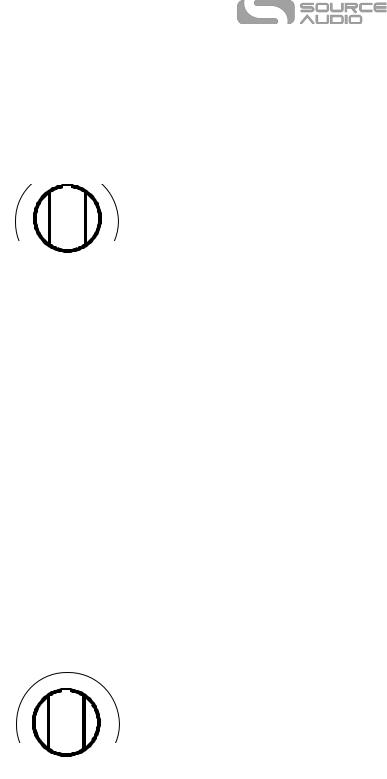
Time Knob Range: 40 milliseconds to 2.6 seconds
Mod and Rate: MOD controls the amount of time modulation (vibrato) and RATE controls the modulation rate as well as the rate of the tremolo.
Intensity: Controls the depth of the tremolo.
Moderate Tremolo
Subtle Tremolo |
Intense Tremolo |
SEQUENCED FILTERS (14)
This is a 4-tap delay with a fixed filter on each tap. The filters (a collection of resonant low-pass filters and band-pass filters) are centered at different frequencies so the overall effect feels like a moving filter controlled by a step sequencer. Since this delay engine contains 4 taps which are evenly spaced over the primary delay, you should tap in the tap tempo rate at a quarter of the desired rate.
Time Knob Range: 10 milliseconds to 2.6 seconds
Mod and Rate: Control time (pitch) modulation depth and speed.
Intensity: Controls the amount of distortion in the wet delayed signal. Full counter-clockwise is no distortion. Full clockwise is maximum distortion.
DUB (15)
This is a diffused high-pass filtered delay that feels right at home in a rasta dub tune.
Time Knob Range: 10 milliseconds to 2.6 seconds
Mod and Rate: Control time (pitch) modulation depth and speed
Intensity: Controls the amount of high pass filter applied to the repeats, making them thinner over time, in a style typical of dub music.
Bright |
Very Thin |
CHORUS (16)
Repeats are sent through a stereo chorus effect for a warm modulation sound.
Time Knob Range: 50 milliseconds to 2.6 seconds
Mod and Rate: Controls the amount and speed of the chorus modulation.
SA260 |
Nemesis Delay User’s Guide |
15 |
